I’m excited. I started working on my open-source HD micro frame roughly two months ago. Since then, I’ve assembled a Shapeoko XXL CNC machine, learned how to use the machine to cut carbon fiber, and I’ve flown several iterations of my frame design. I’m certain that there will be more changes to come, but I am quite pleased with the design so far, so I’ve decided to slap a Version 1.0 sticker on it!
My current build is using EMAX 1306 4000 kv motors, and it weighs 223 grams with a 650 mAh 4S pack. I usually get around 5 minutes of fairly aggressive freestyle out of it.
My friend Brian transplanted his Diatone GT-M3 to a Kestrel frame. With his HGLRC 1407 motors, he’s coming in at 253 grams with the same battery. He’s a bit over the 250 gram limit, but not by much!
- I Bought a CNC Machine: I Have No Idea What I’m Doing at patshead.com
The Kestrel is licensed under the GNU GPL 2
I planned for the Kestrel to be open source from the beginning, but which license should I use? The choice of license was actually quite simple. I borrowed an awesome fillet function for OpenSCAD from Github, and that fillet function was licensed under the GNU GPL.
Since I wanted to include that function in my source code, I had to license it under the GNU GPL 2 as well.

There aren’t a lot of open-source FPV quadcopter frames to choose from. The most popular would be the TBS Source One frame. How does releasing an open-source frame help you?
If I stop manufacturing frames, you could still acquire spare parts from someone else—I haven’t even figured out how to manufacture or sell these frames! If you have access to a CNC machine, you can cut your own. I wish CNC machines were as readily available as 3D printers!
If the source code is available, won’t that make it easier to clone the Kestrel?
Yes, it will, but only slightly. Copying a frame is extremely easy. All you need is the piece of the frame and a scanner. Almost anyone could pull it off.
I am much more excited about giving you the ability to cut your own frame than I am worried about someone selling copies of my design!
The little warble my poor Kestrel has had on the pitch axis ever since upgrading the motors seems to be gone. It is nice to have an inexpensive "hold my beer" HD quad in my bag! pic.twitter.com/YW12ygHRIt
— Pat Regan (@patsheadcom) March 21, 2019
What can I do with the source code?
The Kestrel is designed using OpenSCAD. OpenSCAD is an open-source CAD package. Instead of creating your objects by dragging and dropping various shapes and operations around the screen with your mouse, everything is defined using OpenSCAD’s programming language. Everything is built from unions and differences of basic shapes like cubes, spheres, and cylinders.
If you’re a programmer, this may be easier for you to handle than a traditional CAD package. OpenSCAD excels when you need to build objects that match precise measurements. You’ll start to get into the weeds when you try to model more organic shapes.
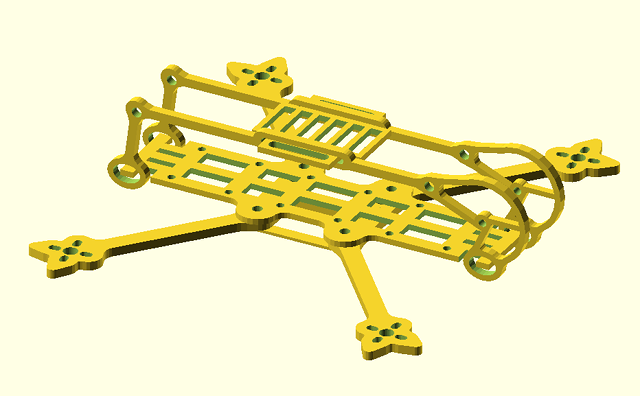
Modeling in OpenSCAD requires more work up front, but it can pay off in the long run. The most time-consuming task when creating the Kestrel was getting the guitar-shaped motor mounts right. The mounts are built up using a configuration of hulls and fillets of a variety of discs.
The diameter and spacing of those discs is based on the distance between the motor’s mounting holes. The entire mount had to work well with the 9 mm hole spacing of an 1106 motor up to the 16 mm hole spacing of a 2207 motor. Getting the ratios and angles correct to make either extreme look right was challenging!
I think it was worth the extra work. There are quite a few important parameters of the frame that can now be adjusted by simply adjusting the measurements in variables at the top of the OpenSCAD source code.
- Motor mount hole spacing
- Arm length
- Arm angle
- Arm width
- FPV camera’s protection diameter
- FPV camera’s relative positioning
- Side plate thickness
- Height available to the stack
- Grommet hole length and height
- Grommet tab depth and width
Do you want to build the tightest 2.5” HD micro quad? You can punch new measurements into two or three variables, and you can get the props as close to each other and the fuselage as you’d like.

My 3” configuration pushes the motors out just about as far as they can go. If they were much longer, I would have had to extend my motor wires. Longer arms help deliver clean air to each propeller, and the extra leverage makes the quad more stable.
Do you want to fly a spindly, lightweight 6” HD quad? You could easily cut some crazy arms for the Kestrel, and I am more than a little tempted to try this!
- Kestrel frame at Gitlab
- Kestrel frame at Thingiverse
The bushings probably need tweaking
Are they bushings or grommets? McMaster-Carr calls them grommets, but I seem to keep changing my mind.
This is the part of the frame that I need to get right. The Acrobrat comes with three different sets of bushings with various hardness ratings. McMaster stocks an appropriate bushing, and a 100 pack was less than $10. I didn’t get to choose the stiffness, though. They’re rated at a shore hardness of 55. That’s pretty close to the medium-stiffness bushing that ships with the Acrobrat.
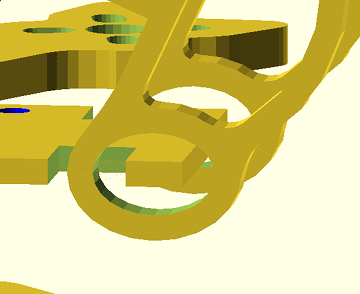
I can’t modify the stiffness, but I can adjust how tightly the grommet fits over the tabs on the bottom plate. My first prototype was too tight. I don’t even think the rubber was loose enough to absorb any vibration at all!
I’ve loosened it up quite a bit. I made the tabs narrower, and I made the oval-shaped grommet hole in the side plate a bit taller. There’s a good bit of play in there now—hopefully not too much!
I’m going to try a 4” build!
The 3” version of the Kestrel is flying quite well. I’ve had some trouble with my 1306 build, but I think I’ve gotten it mostly under control—I hope! Brian’s 1407 build is flying great, even though he didn’t quite manage to fit under the 250-gram limit—not that he has any need to!
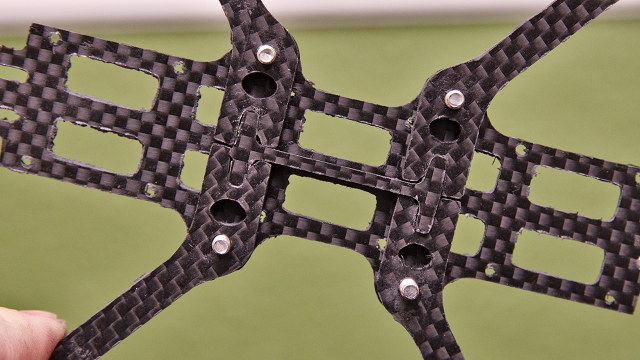
I’d like to order some parts to build a lightweight 4” quad. I’m having a hard time choosing hardware. I like the EMAX 1606 3300 KV motors, but choosing a 20x20 stack is difficult!
The motors aren’t much heavier than my 1306 motors, and longer, thicker arms will only add about five extra grams. I’m hopeful that my build will fit in under 250 grams, but I won’t be too upset if I exceed that weight.
It has been two years since I flew a 4” quad. That old 4” quad had 2204 2750 KV motors. I’m hoping that the difference between a heavy 3” build and a light 4” build feels a lot like the difference between a 5” and 5” quad. It should have more bottom end, so it will be easier to catch the quad when falling out of a dive. It should also be more efficient, so I’m expecting to get longer flights. It will probably be less responsive, but the 3” almost feels twitchy to me, so that might be a bonus!
If the 4” build flies well and fits in under 250 grams, I think it will be an interesting build for the parts of the world with serious weight restrictions!
Motors are easy. Finding a 20x20 stack that I like is hard!
- Kestrel frame at Gitlab
- Kestrel frame at Thingiverse
There are a few problems with moving to 4”
Tiny boards for 2.5” and 3” micros are plentiful. 4-in-1 ESC boards that can properly handle larger motors and props are somewhat larger, even when they use the 20x20 mm mounting pattern. They also tend to require M3 screws instead of M2 screws.
I can just drill larger holes in my central stack and call it a day, but I have a better plan. I’ve ordered some tiny grommets from McMaster-Carr. If I measured correctly, these grommets should work well for soft mounting a stack that requires M2 screws. The hole these grommets fit into should be just about the right size for an M3 screw, so these will allow for either configuration using the same mounting holes.
I’m looking at two stacks. The Lumenier MICRO LUX V3 stack and the Aikon AK32PIN stack.
These are both 20x20 stacks that require M3 screws. They’re both F4 flight controllers with blheli_32 ESCs. The Aikon ESC is quite a bit larger, but it is capable enough to be used in a 6S 5” miniquad. The Aikon ESC alone costs as much as the Lumenier stack.
The Aikon ESC will be a tough fit, but it looks like I can squeeze it in. If I do go this route, and fitting such a large ESC is too difficult, I will probably adjust the length of the fuselage to compensate. Am I going to be moving past version 1.0 this quickly?
The source code is hosted on Gitlab
The OpenSCAD source code, a simple build script, and SVG and DXF output files for several arm configurations are being hosted on Gitlab.
There are configurations for two sets of 3” arms, one set of 4” arms, and a ridiculous set of 6” arms. Only one set of 3” arms has been flight tested. All the 3” and 4” arms are built by the build script, and the SVG and DXF files to cut those frames are in the output directory. I left the 6” arms out of the build script, because they’re just crazy.
- Kestrel frame at Gitlab
- Kestrel frame at Thingiverse
What makes the Kestrel unique?
I wanted to build a 3” Acrobrat, but I don’t think the Acrobrat is the frame for me. I wanted to use 1106 motors, and I wanted to keep the weight down. The Acrobrat is a big, heavy frame. I believe it comes in at 54 grams with all the hardware. I hoped I could build something more appropriate for my own needs, and I think I’ve done a reasonable job!
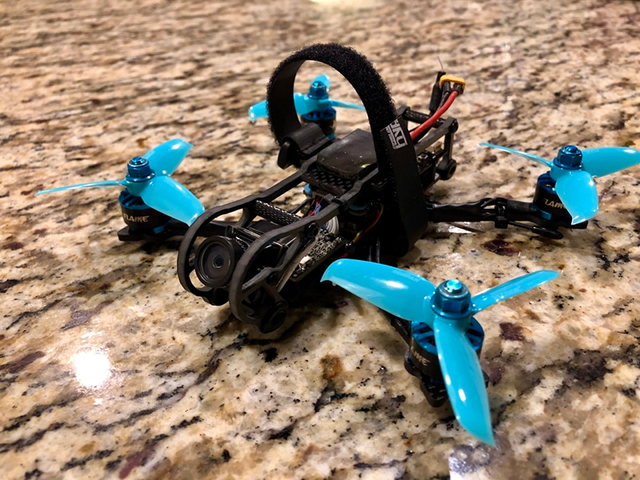
The Kestrel uses individual, replaceable arms. Those arms are easily configurable, so it should be possible to run anything from extremely short and tight 2.5” props on 1106 motors, 5” props on 2207 motors, or anything in between. Each arm is held in place with a single screw, so they are easy to replace in the field.
The arms are positioned to keep the props completely out of view of the HD camera.
I wanted to fit three 20x20 stacks, just like the Acrobrat. Having all that space makes it so much easier to build and repair your micro quad. In addition to room for three stacks, the M3 screws for the motors also line up with a standard 30.5x30.5 stack.
The Kestrel uses a suspension system like the Acrobrat’s. The weight of the battery and HD camera are separated from the vibrations of the motors by rubber bushings.

A Kestrel frame with long 3” arms currently weighs 39 grams. That’s about 15 grams lighter than the Acrobrat. I’m quite certain the Acrobrat is sturdier, but I’m hopeful that the Kestrel is just sturdy enough! Time and crashes will let us know for sure.
- Kestrel frame at Gitlab
- Kestrel frame at Thingiverse
- Ummagawd Acrobrat at Rotor Riot
How do we keep Pat working on open-source frames?!
I’d love to tell you to buy a frame, but selling frames isn’t easy—especially if you’ve never done it before!
I’m just barely beginning to investigate having 3” Kestrel frames manufactured. There’s no shortage of companies in China that will do this sort of thing for you, and it seems inexpensive—even for fairly small batches! I’m more than a little worried about attempting this, but if there’s enough interest, I’ll do what I can to have frames manufactured.
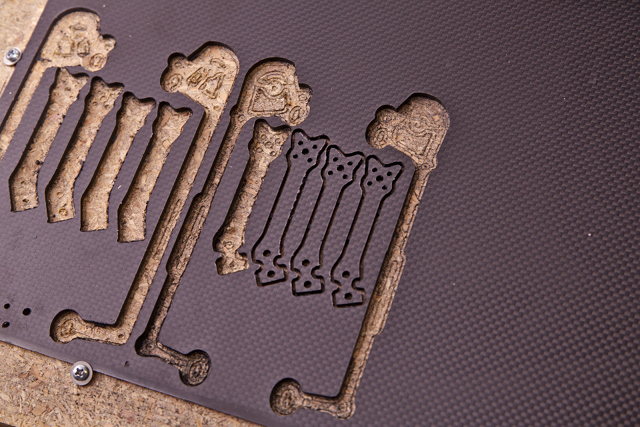
I plan to at least offer a limited quantity of 3” Kestrel in my store on Tindie. If you’d like to buy a Kestrel, you can always get in touch with me, and I’m sure we can work something out. I don’t even know how much I should charge!
If you think I’m doing interesting work, and you’d like to see me continue, you can always become a Patron. A few dollars a month goes a long way towards carbon fiber, replacing dull end mills, and helping me recoup the cost of the CNC machine.
I’ve probably already gone through $50 to $100 worth of carbon fiber sheets on test parts. Every tweak to the frame eats $5 to $10 worth of material, and after two or three frames, I need to throw away a dull end mill. The costs add up fast!
You can also help me out on Youtube. Subscriptions are awesome. Comments are even better. More eyeballs on the Kestrel will make it easier for me to work out manufacturing!
Conclusion
I’m excited to be contributing an Open-Source FPV quadcopter frame to the community. I wish CNC machines were as prolific and available as 3D printers, but I’m still hoping someone will be interested enough to cut a frame for themselves!
I’m starting to send frames out for testing. If you’re interested in testing the Kestrel, feel free to get in touch with me. I’m planning on sending some out for not much more than the cost of the carbon and shipping. Does it count as selling if I’m losing money?
Are you flying an Acrobrat? Are you flying a different HD micro frame? Have you been hoping for a lighter Acrobrat-like frame with replaceable arms? I’d love to hear about what you’re flying! You can leave a comment below, or you can stop by our Discord server and chat about it!
- Kestrel frame at Gitlab
- Kestrel frame at Thingiverse
- Ummagawd Acrobrat at Rotor Riot
- I Bought a CNC Machine: I Have No Idea What I’m Doing at patshead.com
- Support Pat at Patreon
- My Tindie store